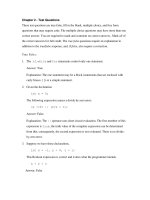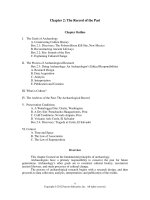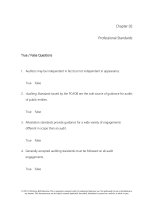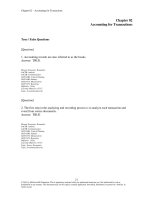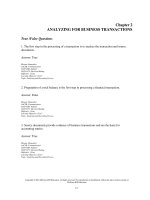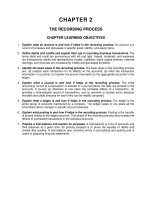Financial accounting fundamentals 5th edition wild test bank
Bạn đang xem bản rút gọn của tài liệu. Xem và tải ngay bản đầy đủ của tài liệu tại đây (759.11 KB, 126 trang )
Chapter 2
ANALYZING FOR BUSINESS TRANSACTIONS
True /False Questions
1. The first step in the processing of a transaction is to analyze the transaction and source
documents.
Answer: True
Blooms: Remember
AACSB: Communication
AICPA BB: Industry
AICPA FN: Decision Making
Difficulty: 1 Easy
Learning Objective: 02-C1
Topic: Analyzing and Recording Process
2. Preparation of a trial balance is the first step in processing a financial transaction.
Answer: False
Blooms: Remember
AACSB: Communication
AICPA BB: Industry
AICPA FN: Decision Making
Difficulty: 1 Easy
Learning Objective: 02-C1
Topic: Analyzing and Recording Process
3. Source documents provide evidence of business transactions and are the basis for
accounting entries.
Answer: True
Blooms: Remember
AACSB: Communication
AICPA BB: Industry
AICPA FN: Decision Making
Difficulty: 1 Easy
Learning Objective: 02-C1
Topic: Analyzing and Recording Process
Copyright © 2016 McGraw-Hill Education. All rights reserved. No reproduction or distribution without the prior written consent of
McGraw-Hill Education
2-1
4. Items such as sales tickets, bank statements, checks, and purchase orders are examples of a
business’s source documents.
Answer: True
Blooms: Remember
AACSB: Communication
AICPA BB: Industry
AICPA FN: Decision Making
Difficulty: 1 Easy
Learning Objective: 02-C1
Topic: Analyzing and Recording Process
5. An account is a record of increases and decreases in a specific asset, liability, equity,
revenue, or expense item.
Answer: True
Blooms: Remember
AACSB: Communication
AICPA BB: Industry
AICPA FN: Decision Making
Difficulty: 1 Easy
Learning Objective: 02-C2
Topic: The Account and Its Analysis
6. A customer’s promise to pay on credit is classified as an account payable by the seller.
Answer: False
Blooms: Remember
AACSB: Communication
AICPA BB: Industry
AICPA FN: Decision Making
Difficulty: 1 Easy
Learning Objective: 02-C2
Topic: The Account and Its Analysis
7. Dividends paid to the stockholders are a business expense.
Answer: False
Blooms: Remember
AACSB: Communication
AICPA BB: Industry
AICPA FN: Decision Making
Difficulty: 1 Easy
Learning Objective: 02-C2
Topic: The Account and Its Analysis
Copyright © 2016 McGraw-Hill Education. All rights reserved. No reproduction or distribution without the prior written consent of
McGraw-Hill Education
2-2
8. The purchase of land and buildings will generally be recorded in the same ledger account.
Answer: False
Blooms: Remember
AACSB: Communication
AICPA BB: Industry
AICPA FN: Decision Making
Difficulty: 1 Easy
Learning Objective: 02-C2
Topic: The Account and Its Analysis
9. Unearned revenues are classified as liabilities.
Answer: True
Blooms: Remember
AACSB: Communication
AICPA BB: Industry
AICPA FN: Decision Making
Difficulty: 1 Easy
Learning Objective: 02-C2
Topic: The Account and Its Analysis
10. Cash paid to stockholders by the business of a corporation and used for personal expenses,
should be treated as an expense of the business.
Answer: False
Blooms: Remember
AACSB: Communication
AICPA BB: Industry
AICPA FN: Decision Making
Difficulty: 1 Easy
Learning Objective: 02-C2
Topic: The Account and Its Analysis
11. When a company provides services for which cash will not be received until some future
date, the company should record the amount charged as accounts receivable.
Answer: True
Blooms: Understand
AACSB: Communication
AICPA BB: Industry
AICPA FN: Decision Making
Difficulty:2 Medium
Learning Objective: 02-C2
Topic: The Account and Its Analysis
Copyright © 2016 McGraw-Hill Education. All rights reserved. No reproduction or distribution without the prior written consent of
McGraw-Hill Education
2-3
12. A company’s chart of accounts is a list of all the accounts used and includes an
identification number assigned to each account.
Answer: True
Blooms: Remember
AACSB: Communication
AICPA BB: Industry
AICPA FN: Decision Making
Difficulty: 1 Easy
Learning Objective: 02-C3
Topic: Ledger and Chart of Accounts
13. An account’s balance is the difference between the total debits and total credits for the
account, including any beginning balance.
Answer: True
Blooms: Remember
AACSB: Communication
AICPA BB: Industry
AICPA FN: Decision Making
Difficulty: 1 Easy
Learning Objective: 02-C2
Topic: The Account and its Analysis
14. The right side of an account is called the debit side.
Answer: False
Blooms: Remember
AACSB: Communication
AICPA BB: Industry
AICPA FN: Decision Making
Difficulty: 1 Easy
Learning Objective: 02-C4
Topic: Debits and Credits
15. In a double-entry accounting system, the total dollar amount debited must always equal
the total dollar amount credited.
Answer: True
Blooms: Remember
AACSB: Communication
AICPA BB: Industry
AICPA FN: Decision Making
Difficulty: 1 Easy
Learning Objective: 02-C4
Topic: Debits and Credits
Copyright © 2016 McGraw-Hill Education. All rights reserved. No reproduction or distribution without the prior written consent of
McGraw-Hill Education
2-4
16. Increases in liability accounts are recorded as debits.
Answer: False
Blooms: Understand
AACSB: Communication
AICPA BB: Industry
AICPA FN: Decision Making
Difficulty: 2 Medium
Learning Objective: 02-C4
Topic: Debits and Credits
17. Debits increase asset and expense accounts.
Answer: True
Blooms: Understand
AACSB: Communication
AICPA BB: Industry
AICPA FN: Decision Making
Difficulty: 2 Medium
Learning Objective: 02-C4
Topic: Debits and Credits
18. Credits always increase account balances.
Answer: False
Blooms: Understand
AACSB: Communication
AICPA BB: Industry
AICPA FN: Decision Making
Difficulty: 2 Medium
Learning Objective: 02-C4
Topic: Debits and Credits
19. Crediting an expense account decreases it.
Answer: True
Blooms: Understand
AACSB: Communication
AICPA BB: Industry
AICPA FN: Decision Making
Difficulty: 2 Medium
Learning Objective: 02-C4
Topic: Debits and Credits
Copyright © 2016 McGraw-Hill Education. All rights reserved. No reproduction or distribution without the prior written consent of
McGraw-Hill Education
2-5
20. A revenue account normally has a debit balance.
Answer: False
Blooms: Understand
AACSB: Communication
AICPA BB: Industry
AICPA FN: Decision Making
Difficulty: 2 Medium
Learning Objective: 02-C4
Topic: Debits and Credits
21. Asset accounts are normally decreased by debits.
Answer: False
Blooms: Understand
AACSB: Communication
AICPA BB: Industry
AICPA FN: Decision Making
Difficulty: 2 Medium
Learning Objective: 02-C4
Topic: Debits and Credits
22. Debit means increase and credit means decrease for all accounts.
Answer: False
Blooms: Understand
AACSB: Communication
AICPA BB: Industry
AICPA FN: Decision Making
Difficulty: 2 Medium
Learning Objective: 02-C4
Topic: Debits and Credits
23. Asset accounts normally have debit balances and revenue accounts normally have credit
balances.
Answer: True
Blooms: Understand
AACSB: Communication
AICPA BB: Industry
AICPA FN: Decision Making
Difficulty: 2 Medium
Learning Objective: 02-C4
Topic: Debits and Credits
Copyright © 2016 McGraw-Hill Education. All rights reserved. No reproduction or distribution without the prior written consent of
McGraw-Hill Education
2-6
24. A dividend normally has a debit balance.
Answer: True
Blooms: Remember
AACSB: Communication
AICPA BB: Industry
AICPA FN: Decision Making
Difficulty: 1 Easy
Learning Objective: 02-C4
Topic: Debits and Credits
25. A debit entry is always an increase in the account.
Answer: False
Blooms: Understand
AACSB: Communication
AICPA BB: Industry
AICPA FN: Decision Making
Difficulty: 2 Medium
Learning Objective: 02-C4
Topic: Debits and Credits
26. A transaction that credits an asset account and credits a liability account must also affect
one or more other accounts.
Answer: True
Blooms: Apply
AACSB: Analytic
AICPA BB: Industry
AICPA FN: Decision Making
Difficulty: 3 Hard
Learning Objective: 02-A1
Topic: Analyzing Transactions
27. A transaction that decreases a liability and increases an asset must also affect one or more
other accounts.
Answer: True
Blooms: Apply
AACSB: Analytic
AICPA BB: Industry
AICPA FN: Decision Making
Difficulty: 3 Hard
Learning Objective: 02-A1
Topic: Analyzing Transactions
Copyright © 2016 McGraw-Hill Education. All rights reserved. No reproduction or distribution without the prior written consent of
McGraw-Hill Education
2-7
28. If insurance coverage for the next two years is paid for in advance, the amount of the
payment is debited to an asset account called Prepaid Insurance.
Answer: True
Blooms: Understand
AACSB: Analytic
AICPA BB: Industry
AICPA FN: Decision Making
Difficulty: 2 Medium
Learning Objective: 02-A1
Topic: Analyzing Transactions
29. The purchase of supplies on credit should be recorded with a debit to Supplies and a credit
to Accounts Payable.
Answer: True
Blooms: Understand
AACSB: Analytic
AICPA BB: Industry
AICPA FN: Decision Making
Difficulty: 2 Medium
Learning Objective: 02-A1
Topic: Analyzing Transactions
30. If a company purchases equipment paying cash, the journal entry to record this transaction
will include a debit to Cash.
Answer: False
Blooms: Understand
AACSB: Analytic
AICPA BB: Industry
AICPA FN: Decision Making
Difficulty: 2 Medium
Learning Objective: 02-A1
Topic: Analyzing Transactions
31. If a company provides services to a customer on credit, the company providing the
service should credit Accounts Receivable.
Answer: False
Blooms: Understand
AACSB: Analytic
AICPA BB: Industry
AICPA FN: Decision Making
Difficulty: 2 Medium
Learning Objective: 02-A1
Topic: Analyzing Transactions
Copyright © 2016 McGraw-Hill Education. All rights reserved. No reproduction or distribution without the prior written consent of
McGraw-Hill Education
2-8
32. When a company bills a customer for $700 for services rendered, the journal entry to
record this transaction will include a $700 debit to Services Revenue.
Answer: False
Blooms: Apply
AACSB: Analytic
AICPA BB: Industry
AICPA FN: Decision Making
Difficulty: 3 Hard
Learning Objective: 02-A1
Topic: Analyzing Transactions
33. The debt ratio helps to assess the risk a company has of failing to pay its debts and is
helpful to both its owners and creditors.
Answer: True
Blooms: Understand
AACSB: Analytic
AICPA BB: Industry
AICPA FN: Decision Making
Difficulty: 2 Medium
Learning Objective: 02-A2
Topic: Debt Ratio
34. The higher a company’s debt ratio, the lower the risk of a company not being able to meet
its obligations.
Answer: False
Blooms: Understand
AACSB: Analytic
AICPA BB: Industry
AICPA FN: Decision Making
Difficulty: 2 Medium
Learning Objective: 02-A2
Topic: Debt Ratio
35. The debt ratio is calculated by dividing total assets by total liabilities.
Answer: False
Blooms: Remember
AACSB: Analytic
AICPA BB: Industry
AICPA FN: Decision Making
Difficulty: 1 Easy
Learning Objective: 02-A2
Topic: Debt Ratio
Copyright © 2016 McGraw-Hill Education. All rights reserved. No reproduction or distribution without the prior written consent of
McGraw-Hill Education
2-9
36. A company that finances a relatively large portion of its assets with liabilities is said to
have a high degree of financial leverage.
Answer: True
Blooms: Understand
AACSB: Analytic
AICPA BB: Industry
AICPA FN: Decision Making
Difficulty: 2 Medium
Learning Objective: 02-A2
Topic: Debt Ratio
37. If a company is highly leveraged, this means that it has relatively high risk of not being
able to repay its debt.
Answer: True
Blooms: Understand
AACSB: Analytic
AICPA BB: Industry
AICPA FN: Decision Making
Difficulty: 2 Medium
Learning Objective: 02-A2
Topic: Debt Ratio
38. Booth Industries has liabilities of $105 million and total assets of $350 million. Its debt
ratio is 40.0%.
Answer: False
Blooms: Apply
AACSB: Analytic
AICPA BB: Industry
AICPA FN: Decision Making
Difficulty:3 Hard
Learning Objective: 02-A2
Topic: Debt Ratio
Feedback: Debt Ratio = Total Liabilities/Total Assets
Debt Ratio = $105 million/$350 million = 30%
39. A journal entry that affects no more than two accounts is called a compound entry.
Answer: False
Blooms: Remember
AACSB: Reflective Thinking
AICPA BB: Industry
AICPA FN: Decision Making
Difficulty: Easy
Learning 1 Objective: 02-A1
Topic: Analyzing Transactions
Copyright © 2016 McGraw-Hill Education. All rights reserved. No reproduction or distribution without the prior written consent of
McGraw-Hill Education
2-10
40. Posting is the transfer of journal entry information to the ledger.
Answer: True
Blooms: Remember
AACSB: Communication
AICPA BB: Industry
AICPA FN: Decision Making
Difficulty: 1 Easy
Learning Objective: 02-P1
Topic: Journalizing and Posting Transactions
41. Transactions are recorded first in the ledger and then transferred to the journal.
Answer: False
Blooms: Remember
AACSB: Communication
AICPA BB: Industry
AICPA FN: Decision Making
Difficulty: 1 Easy
Learning Objective: 02-P1
Topic: Journalizing and Posting Transactions
42. The journal is known as a book of original entry.
Answer: True
Blooms: Remember
AACSB: Communication
AICPA BB: Industry
AICPA FN: Decision Making
Difficulty: 1 Easy
Learning Objective: 02-P1
Topic: Journalizing and Posting Transactions
43. A general journal gives a complete record of each transaction in one place, and shows the
debits and credits for each transaction.
Answer: True
Blooms: Remember
AACSB: Communication
AICPA BB: Industry
AICPA FN: Decision Making
Difficulty: 1 Easy
Learning Objective: 02-P1
Topic: Journalizing and Posting Transactions
Copyright © 2016 McGraw-Hill Education. All rights reserved. No reproduction or distribution without the prior written consent of
McGraw-Hill Education
2-11
44. The general journal is known as the book of final entry because financial statements are
prepared from it.
Answer: False
Blooms: Remember
AACSB: Communication
AICPA BB: Industry
AICPA FN: Decision Making
Difficulty: 1 Easy
Learning Objective: 02-P1
Topic: Journalizing and Posting Transactions
45. At a given point in time, a business’s trial balance is a list of all of its general ledger
accounts and their balances
Answer: True
Blooms: Remember
AACSB: Communication
AICPA BB: Industry
AICPA FN: Decision Making
Difficulty: 1 Easy
Learning Objective: 02-P2
Topic: Preparing a Trial Balance
46. The ordering of accounts in a trial balance typically follows their identification number
from the chart of accounts, that is, assets first, then liabilities, then common stock and
dividends, followed by revenues and expenses.
Answer: True
Blooms: Remember
AACSB: Analytic
AICPA BB: Industry
AICPA FN: Decision Making
Difficulty: 1 Easy
Learning Objective: 02-P2
Topic: Preparing a Trial Balance
47. The trial balance can serve as a replacement for the balance sheet, since total debits must
equal total credits.
Answer: False
Blooms: Understand
AACSB: Analytic
AICPA BB: Industry
AICPA FN: Decision Making
Difficulty: 2 Medium
Learning Objective: 02-P2
Topic: Preparing a Trial Balance
Copyright © 2016 McGraw-Hill Education. All rights reserved. No reproduction or distribution without the prior written consent of
McGraw-Hill Education
2-12
48. A balanced trial balance is proof that no errors were made in journalizing transactions,
posting to the ledger, and preparing the trial balance.
Answer: False
Blooms: Remember
AACSB: Communication
AICPA BB: Industry
AICPA FN: Decision Making
Difficulty: 1 Easy
Learning Objective: 02-P2
Topic: Preparing a Trial Balance
49. If cash was incorrectly debited for $100 instead of correctly crediting it for $100, the cash
account’s balance will be overstated (too high).
Answer: True
Blooms: Apply
AACSB: Analytic
AICPA BB: Industry
AICPA FN: Decision Making
Difficulty: 2 Medium
Learning Objective: 02-A1
Topic: Analyzing Transactions
50. The financial statement that summarizes the changes in retained earnings is called the
balance sheet.
Answer: False
Blooms: Understand
AACSB: Communication
AICPA BB: Industry
AICPA FN: Decision Making
Difficulty: 2 Medium
Learning Objective: 02-P3
Topic: Financial Statements
51. The heading on every financial statement lists the three W’s—Who (the name of the
business); What (the name of the statement); and Where (the organization’s address)
Answer: False
Blooms: Understand
AACSB: Communication
AICPA BB: Industry
AICPA FN: Reporting
Difficulty: 2 Medium
Learning Objective: 02-P3
Topic: Financial Statements
Copyright © 2016 McGraw-Hill Education. All rights reserved. No reproduction or distribution without the prior written consent of
McGraw-Hill Education
2-13
52. If common stock account had a $10,000 credit balance at the beginning of the period, and
during the period, the stockholders invest an additional $5,000, the balance in the common
stock account listed on the trial balance will be equal to a debit balance of $5,000.
Answer: False
Feedback: $10,000cr + $5,000cr =$15,000 credit balance
Blooms: Understand
AACSB: Communication
AICPA BB: Industry
AICPA FN: Reporting
Difficulty: 2 Medium
Learning Objective 02-C4
Learning Objective: 02-P2
Topic: Debits and Credits
Topic: Preparing a Trial Balance
53. Dividends are not reported on a business’s income statement.
Answer: True
Blooms: Understand
AACSB: Communication
AICPA BB: Industry
AICPA FN: Reporting
Difficulty: 2 Medium
Learning Objective: 02-P3
Topic: Financial Statements
54. An income statement reports the revenues earned less the expenses incurred by a business
over a period of time.
Answer: True
Blooms: Understand
AACSB: Communication
AICPA BB: Industry
AICPA FN: Reporting
Difficulty: 2 Medium
Learning Objective: 02-P3
Topic: Financial Statements
55. The balance sheet reports the financial position of a company at a point in time.
Answer: True
Blooms: Understand
AACSB: Communication
AICPA BB: Industry
AICPA FN: Reporting
Difficulty: 2 Medium
Learning Objective: 02-P3
Copyright © 2016 McGraw-Hill Education. All rights reserved. No reproduction or distribution without the prior written consent of
McGraw-Hill Education
2-14
Topic: Financial Statements
56. The same four basic financial statements are prepared by both U.S. GAAP and IFRS.
Answer: True
Blooms: Understand
AACSB: Communication
AICPA BB: Global
AICPA FN: Reporting
Difficulty: 2 Medium
Learning Objective: 02-P3
Topic: Financial Statements
57. Neither U.S. GAAP nor IFRS require the use of accrual basis accounting.
Answer: False
Blooms: Understand
AACSB: Communication
AICPA BB: Global
AICPA FN: Reporting
Difficulty: 2 Medium
Learning Objective: 02-P3
Topic: Financial Statements
Multiple Choice Questions
58. The accounting process begins with:
A. Analysis of business transactions and source documents.
B. Preparing financial statements and other reports.
C. Summarizing the recorded effect of business transactions.
D. Presentation of financial information to decision-makers.
E. Preparation of the trial balance.
Answer: A
Blooms: Understand
AACSB: Communication
AICPA BB: Industry
AICPA FN: Decision Making
Difficulty: 2 Medium
Learning Objective: 02-C1
Topic: Analyzing and Recording Process
Copyright © 2016 McGraw-Hill Education. All rights reserved. No reproduction or distribution without the prior written consent of
McGraw-Hill Education
2-15
59. All of the following statements regarding a sales invoice are true except:
A. A sales invoice is a type of source document.
B. A sales invoice is used by sellers to record the sale and for control.
C. A sales invoice is used by buyers to record purchases and monitor purchasing activity.
D. A sales invoice gives rise to an entry in the accounting process.
E. A sales invoice does not provide objective evidence about a transaction.
Answer: E
Blooms: Understand
AACSB: Communication
AICPA BB: Industry
AICPA FN: Decision Making
Difficulty: 2 Medium
Learning Objective: 02-C1
Topic: Analyzing and Recording Process
60. A business’s source documents may include all of the following except:
A. Sales tickets.
B. Ledgers.
C. Checks.
D. Purchase orders.
E. Bank statements.
Answer: B
Blooms: Understand
AACSB: Communication
AICPA BB: Industry
AICPA FN: Decision Making
Difficulty: 2 Medium
Learning Objective: 02-C1
Topic: Analyzing and Recording Process
61. A business’s source documents:
A. include the ledger.
B. Provide objective evidence that a transaction has taken place.
C. must be in electronic form.
D. are prepared internally to ensure accuracy.
E. include the chart of accounts.
Answer: B
Blooms: Understand
AACSB: Communication
AICPA BB: Industry
AICPA FN: Decision Making
Difficulty: 2 Medium
Learning Objective: 02-C1
Topic: Analyzing and Recording Process
Copyright © 2016 McGraw-Hill Education. All rights reserved. No reproduction or distribution without the prior written consent of
McGraw-Hill Education
2-16
62. A business’s record of the increases and decreases in a specific asset, liability, equity,
revenue, or expense is known as a(n):
A. Journal.
B. Posting.
C. Trial balance.
D. Account.
E. Chart of accounts.
Answer: D
Blooms: Remember
AACSB: Communication
AICPA BB: Industry
AICPA FN: Decision Making
Difficulty: 1 Easy
Learning Objective: 02-C2
Topic: The Account and Its Analysis
63. An account used to record the stockholders’ investments in a business is called a(n):
A. Dividends account.
B. Common stock account.
C. Revenue account.
D. Expense account.
E. Liability account.
Answer: B
Blooms: Remember
AACSB: Communication
AICPA BB: Industry
AICPA FN: Decision Making
Difficulty: 1 Easy
Learning Objective: 02-C2
Topic: The Account and Its Analysis
64. Identify the account used by businesses to record the transfer of assets from a business to
its owner for personal use:
A. A revenue account.
B. The dividends account.
C. The common stock account.
D. An expense account.
E. A liability account.
Answer: B
Blooms: Remember
AACSB: Communications
AICPA BB: Industry
AICPA FN: Decision Making
Difficulty: 1 Easy
Learning Objective: 02-C2
Topic: The Account and Its Analysis
Copyright © 2016 McGraw-Hill Education. All rights reserved. No reproduction or distribution without the prior written consent of
McGraw-Hill Education
2-17
65. Identify the statement below that is correct.
A. When a future expense is paid in advance, the payment is normally recorded in a liability
account called Prepaid Expense.
B. Promises of future payment by the customer are called accounts receivable.
C. Increases and decreases in cash are always recorded in the common stock account.
D. An account called Land is commonly used to record increases and decreases in both the
land and buildings owned by a business.
E. Accrued liabilities include accounts receivable.
Answer: B
Blooms: Apply
AACSB: Communication
AICPA BB: Industry
AICPA FN: Decision Making
Difficulty: 3 Hard
Learning Objective: 02-C2
Topic: The Account and Its Analysis
66. Unearned revenues are generally:
A. Revenues that have been earned and received in cash.
B. Revenues that have been earned but not yet collected in cash.
C. Liabilities created when a customer pays in advance for products or services before the
revenue is earned.
D. Recorded as an asset in the accounting records.
E. Increases to stockholders equity.
Answer: C
Blooms: Understand
AACSB: Communication
AICPA BB: Industry
AICPA FN: Measurement
Difficulty: 2 Medium
Learning Objective: 02-C2
Topic: The Account and Its Analysis
Copyright © 2016 McGraw-Hill Education. All rights reserved. No reproduction or distribution without the prior written consent of
McGraw-Hill Education
2-18
67. Prepaid expenses are generally:
A. Payments made for products and services that do not ever expire.
B. Classified as liabilities on the balance sheet.
C. Decreases in equity.
D. Assets that represent prepayments of future expenses.
E. Promises of payments by customers.
Answer: D
Blooms: Understand
AACSB: Communication
AICPA BB: Industry
AICPA FN: Measurement
Difficulty: 2 Medium
Learning Objective: 02-C2
Topic: The Account and Its Analysis
68. A company’s formal promise to pay (in the form of a promissory note) a future amount is
a(n):
A. Unearned revenue.
B. Prepaid expense.
C. Credit account.
D. Note payable.
E. Account receivable.
Answer: D
Blooms: Understand
AACSB: Communication
AICPA BB: Industry
AICPA FN: Measurement
Difficulty: 2 Medium
Learning Objective: 02-C2
Topic: The Account and Its Analysis
69. The record of all accounts and their balances used by a business is called a:
A. Journal.
B. Book of original entry.
C. General Journal.
D. Balance column journal.
E. Ledger.
Answer: E
Blooms: Understand
AACSB: Communication
AICPA BB: Industry
AICPA FN: Decision Making
Difficulty: 2 Medium
Learning Objective: 02-C3
Topic: Ledger and Chart of Accounts
Copyright © 2016 McGraw-Hill Education. All rights reserved. No reproduction or distribution without the prior written consent of
McGraw-Hill Education
2-19
70. A company’s ledger is:
A. A record containing increases and decreases in a specific asset, liability, equity, revenue, or
expense item.
B. A journal in which transactions are first recorded.
C. A collection of documents that describe transactions and events entering the accounting
process.
D. A list of all accounts a company uses with an assigned identification number.
E. A record containing all accounts and their balances used by the company.
Answer: E
Blooms: Understand
AACSB: Communication
AICPA BB: Industry
AICPA FN: Decision Making
Difficulty: 2 Medium
Learning Objective: 02-C3
Topic: Ledger and Chart of Accounts
71. A company’s list of accounts and the identification numbers assigned to each account is
called a:
A. Source document.
B. Journal.
C. Trial balance.
D. Chart of accounts.
E. General Journal.
Answer: D
Blooms: Understand
AACSB: Communication
AICPA BB: Industry
AICPA FN: Reporting
Difficulty: 2 Medium
Learning Objective: 02-C3
Topic: Ledger and Chart of Accounts
Copyright © 2016 McGraw-Hill Education. All rights reserved. No reproduction or distribution without the prior written consent of
McGraw-Hill Education
2-20
72. The numbering system used in a company’s chart of accounts:
A. Is the same for all companies.
B. Is determined by generally accepted accounting principles.
C. Depends on the source documents used in the accounting process.
D. Typically begins with balance sheet accounts.
E. Typically begins with income statement accounts.
Answer: D
Blooms: Understand
AACSB: Communication
AICPA BB: Industry
AICPA FN: Reporting
Difficulty: 2 Medium
Learning Objective: 02-C3
Topic: Ledger and Chart of Accounts
73. A debit:
A. Always increases an account.
B. Is the right-hand side of a T-account.
C. Always decreases an account.
D. Is the left-hand side of a T-account.
E. Is not need to record a transaction.
Answer: D
Blooms: Understand
AACSB: Analytic
AICPA BB: Industry
AICPA FN: Decision Making
Difficulty: 2 Medium
Learning Objective: 02-C4
Topic: Debits and Credits
74. The right side of a T-account is a(n):
A. Debit.
B. Increase.
C. Credit.
D. Decrease.
E. Account balance.
Answer: C
Blooms: Remember
AACSB: Communication
AICPA BB: Industry
AICPA FN: Decision Making
Difficulty: 1 Easy
Learning Objective: 02-C4
Topic: Debits and Credits
Copyright © 2016 McGraw-Hill Education. All rights reserved. No reproduction or distribution without the prior written consent of
McGraw-Hill Education
2-21
75. Identify the statement below that is incorrect.
A. The normal balance of accounts receivable is a debit.
B. The normal balance of dividends is a debit.
C. The normal balance of unearned revenues is a credit.
D. The normal balance of an expense account is a credit.
E. The normal balance of the common stock account is a credit.
Answer: D
Blooms: Understand
AACSB: Analytic
AICPA BB: Industry
AICPA FN: Decision Making
Difficulty: 2 Medium
Learning Objective: 02-C4
Topic: Debits and Credits
76. A credit is used to record an increase in all of the following accounts except:
A. Accounts Payable
B. Service Revenue
C. Unearned Revenue
D. Wages Expense
E. Common Stock
Answer: D
Blooms: Remember
AACSB: Analytic
AICPA BB: Industry
AICPA FN: Decision Making
Difficulty: 2 Medium
Learning Objective: 02-C4
Topic: Debits and Credits
77. A debit is used to record an increase in all of the following accounts except:
A. Supplies
B. Cash
C. Accounts Payable
D. Dividends
E. Prepaid Insurance
Answer: C
Blooms: Remember
AACSB: Analytic
AICPA BB: Industry
AICPA FN: Decision Making
Difficulty: 2 Medium
Learning Objective: 02-C4
Topic: Debits and Credits
Copyright © 2016 McGraw-Hill Education. All rights reserved. No reproduction or distribution without the prior written consent of
McGraw-Hill Education
2-22
78. Identify the account below that is classified as a liability in a company’s chart of
accounts:
A. Cash
B. Unearned Revenue
C. Salaries Expense
D. Accounts Receivable
E. Supplies
Answer: B
Blooms: Remember
AACSB: Analytic
AICPA BB: Industry
AICPA FN: Decision Making
Difficulty: 2 Medium
Learning Objective: 02-C3
Topic: Chart of Accounts
79. Identify the account below that is classified as an asset in a company’s chart of accounts:
A. Accounts Receivable
B. Accounts Payable
C. Common Stock
D. Unearned Revenue
E. Service Revenue
Answer: A
Blooms: Remember
AACSB: Analytic
AICPA BB: Industry
AICPA FN: Decision Making
Difficulty: 1 Easy
Learning Objective: 02-C3
Topic: Chart of Accounts
80. Identify the account below that is classified as an asset account:
A. Unearned Revenue
B. Accounts Payable
C. Supplies
D. Common Stock
E. Service Revenue
Answer: C
Blooms: Remember
AACSB: Analytic
AICPA BB: Industry
AICPA FN: Decision Making
Difficulty: 1 Easy
Learning Objective: 02-C2
Topic: The Account and Its Analysis
Copyright © 2016 McGraw-Hill Education. All rights reserved. No reproduction or distribution without the prior written consent of
McGraw-Hill Education
2-23
81. Identify the account below that is classified as a liability account:
A. Cash
B. Accounts Payable
C. Salaries Expense
D. Common Stock
E. Equipment
Answer: B
Blooms: Remember
AACSB: Analytic
AICPA BB: Industry
AICPA FN: Decision Making
Difficulty: 1 Easy
Learning Objective: 02-C2
Topic: The Account and Its Analysis
82. Identify the account below that impacts the Equity of a business:
A. Utilities Expense
B. Accounts Payable
C. Accounts Receivable
D. Cash
E. Unearned Revenue
Answer: A
Blooms: Remember
AACSB: Analytic
AICPA BB: Industry
AICPA FN: Decision Making
Difficulty: 1 Easy
Learning Objective: 02-C2
Topic: The Account and Its Analysis
83. A business uses a credit to record:
A. An increase in an expense account.
B. A decrease in an asset account.
C. A decrease in an unearned revenue account.
D. A decrease in a revenue account.
E. A decrease in an equity account.
Answer: B
Blooms: Understand
AACSB: Analytic
AICPA BB: Industry
AICPA FN: Decision Making
Difficulty: 2 Medium
Learning Objective: 02-C4
Topic: Debits and Credits
Copyright © 2016 McGraw-Hill Education. All rights reserved. No reproduction or distribution without the prior written consent of
McGraw-Hill Education
2-24
84. A simple tool that is widely used in accounting to represent a ledger account and to
understand how debits and credits affect an account balance is called a:
A. Dividends account.
B. Equity account.
C. Drawing account.
D. T-account.
E. Balance column sheet.
Answer: D
Blooms: Remember
AACSB: Communication
AICPA BB: Industry
AICPA FN: Decision Making
Difficulty: 1 Easy
Learning Objective: 02-C4
Topic: Debits and Credits
85. Identify the statement below that is correct?
A. The left side of a T-account is the credit side.
B. Debits decrease asset and expense accounts, and increase liability, equity, and revenue
accounts.
C. The left side of a T-account is the debit side.
D. Credits increase asset and expense accounts, and decrease liability, equity, and revenue
accounts.
E. In certain circumstances the total amount debited need not equal the total amount credited
for a particular transaction.
Answer: C
Blooms: Understand
AACSB: Analytic
AICPA BB: Industry
AICPA FN: Decision Making
Difficulty: 2 Medium
Learning Objective: 02-C4
Topic: Debits and Credits
Copyright © 2016 McGraw-Hill Education. All rights reserved. No reproduction or distribution without the prior written consent of
McGraw-Hill Education
2-25
